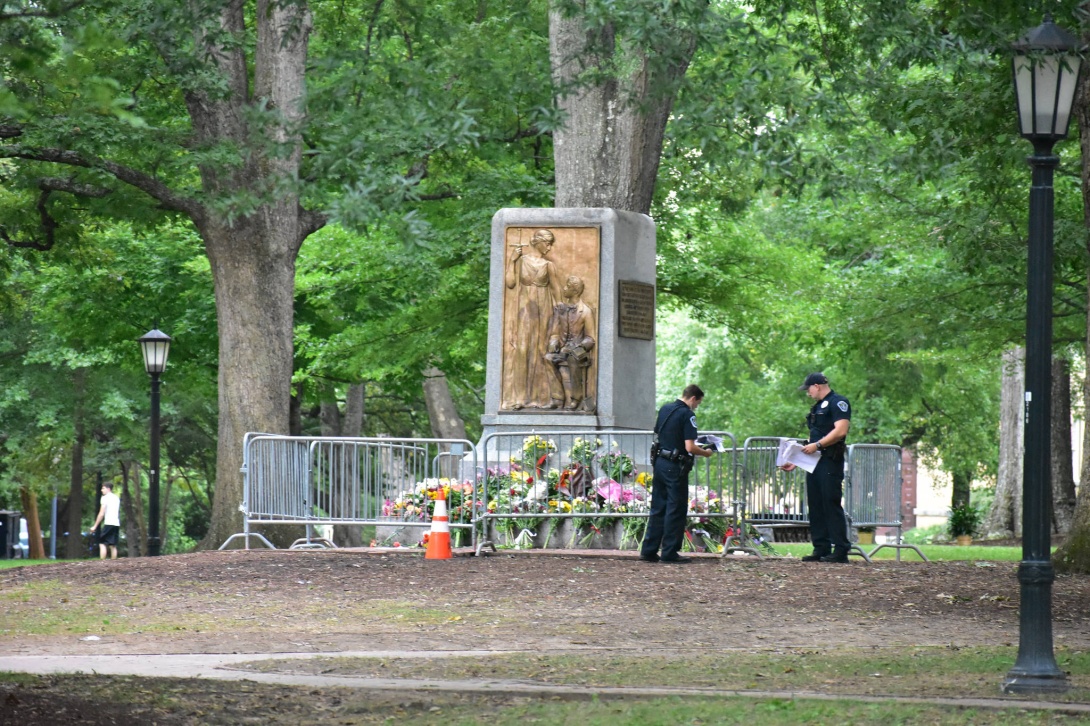The new year brings new challenges for Confederate monuments

After protesters pulled down the "Silent Sam" Confederate statue on UNC-Chapel Hill's campus back in August, only the base of the monument, seen here, remained. In January of this year, Chancellor Carol Folt ordered its removal at the same time she announced she would step down in May. But the UNC Board of Governors, saying it was "incredibly disappointed" by her actions, forced her out instead on Jan. 31. (Photo by Anthony Crider via Flickr.)
Since a Confederate flag-wielding white supremacist massacred nine members of the Emanuel African Methodist Episcopal Church in Charleston, South Carolina, in 2015, the campaign to remove public monuments to slavery-defending Confederates — which goes back decades and got a jolt from the deadly white-supremacist violence in Charlottesville, Virginia, in 2017 — has made significant gains.
A report released last year by the Southern Poverty Law Center identified 113 Confederate symbols in 22 states and the District of Columbia that were removed from public spaces since the Charleston Church shooting. That includes 87 removals in Southern states, with Texas seeing the most at 35 and Virginia in second place with 15. The group currently estimates that more than 1,700 "publicly sponsored symbols" of the Confederacy remain in place, including statues, flags, official observances, and place names.
But the new year has brought new challenges to some of these Confederate memorials:
- One of the movement's highest-profile fights in recent years has been over UNC's "Silent Sam" Confederate statue that stood in a prominent place on the Chapel Hill campus until protesters pulled it down last August. It's been stored in an undisclosed place since then. On Jan. 14, Chancellor Carol Folt — who faced criticism from those on both sides of the monument controversy — announced that she had authorized the removal of the monument's remains, calling them "a continuing threat both to the personal safety and well-being of our community," and said she would step down in May. However, saying they were "incredibly disappointed" by Folt's actions, the UNC Board of Governors forced her to resign on Jan. 31. It also created a five-member committee that has until March 15 to present a full plan for the statue to the board.
- And in Winston-Salem, North Carolina, a judge on Jan. 31 rejected a request from the United Daughters of the Confederacy (UDC) to stop the city from removing a 1905 Confederate statue from a downtown property whose owner also wanted it removed. Though the city offered to pay relocation costs, the UDC said it didn't believe it could legally move the monument because of a North Carolina law passed in 2015 that prohibits the removal of publicly-owned monuments without state permission. However, city officials disagreed with the group's interpretation of the law; citing recent vandalism and the potential for violence, they argued that it allows for the removal of anything determined to be dangerous to to public health or public safety. "I know there are … people who want it there because of history,'' Mayor Allen Joines told the New York Times. "On the other hand, this monument represents oppression and the subjugation of a people, and I know that's hurtful." In the meantime, a group of Democratic state lawmakers has introduced a bill that would overturn the 2015 monuments law, though leaders of the Republican-controlled General Assembly are reluctant to revisit the matter.
- On Jan. 22, South Carolina state officials announced that the last Confederate flag to fly above the statehouse had been placed on display in the Confederate Relic Room and Military Museum in Columbia. The flag had been removed from its place of public prominence after the Charleston church massacre in 2015. Last November, museum staff put the nylon flag into a $1,400 viewing case and placed it amid a display of other historical South Carolina flags.
- On Jan. 18, Texas Gov. Greg Abbott agreed to take down a 60-year-old plaque in the state Capitol that incorrectly said slavery was not the central cause of the Civil War. After years of resistance from Republican leaders, the State Preservation Board, which Abbott leads, voted unanimously to remove the Children of the Confederacy Creed plaque, which stated that "the war between the states was not a rebellion, nor was its underlying cause to sustain slavery." Abbott initially defended the Confederate marker until a conversation with a Democratic state Rep. Eric Johnson, who is African-American. Johnson emphasized the importance of historical accuracy in the state Capitol.
- On Jan. 14, an Alabama judge overturned a state law that barred the removal of Confederate monuments on public property. Jefferson County Circuit Judge Michael Graffeo ruled that the Alabama Memorial Preservation Act of 2017 violated the rights of local communities "repulsed" by a Birmingham monument — a 52-foot pillar that the UDC erected in a city park in 1905 to honor Confederate soldiers. Birmingham Mayor Randall Woodfin praised the judge's ruling, noting, "We were not even a city during the Civil War." But three days after the ruling, state Attorney General Steve Marshall filed an appeal that "seeks to preserve the status quo condition of the Confederate Soldiers and Sailors Monument."
Tags
Benjamin Barber
Benjamin Barber is the democracy program coordinator at the Institute for Southern Studies.
